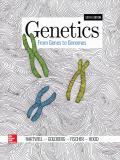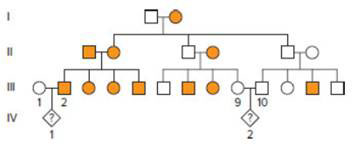
EBK GENETICS: FROM GENES TO GENOMES
6th Edition
ISBN: 9781260041255
Author: HARTWELL
Publisher: MCGRAW HILL BOOK COMPANY
expand_more
expand_more
format_list_bulleted
Concept explainers
Textbook Question
Chapter 2, Problem 47P
The following pedigree shows the inheritance of red hair in a family in Scotland. Red hair is caused by homozygosity for a recessive allele of a gene called MC1R. Although worldwide red hair is the rarest of human hair colors, red hair is not uncommon in Scotland. In fact, 40% of Scots without red hair are nonetheless carriers of the red hair allele.

| a. | Why does red hair show a horizontal inheritance pattern in this particular pedigree even though the trait is caused by a recessive allele? |
| b. | Assuming that individual III-2 has a child with the Scottish woman shown (III-1) who is not a close relative, what is the probability that this child (IV-1) will have red hair? |
| c. | What is the probability that the child of first cousins III-9 and III-10 (IV-2) will have red hair? |
Expert Solution & Answer
Want to see the full answer?
Check out a sample textbook solution
Students have asked these similar questions
Please refer below
AaBbCc X AaBbCc individuals are crossed.
What is the probability of their offspring having a genotype AABBCC?
circle a nucleotide in the image
Chapter 2 Solutions
EBK GENETICS: FROM GENES TO GENOMES
Ch. 2 - For each of the terms in the left column, choose...Ch. 2 - During the millennia in which selective breeding...Ch. 2 - Describe the characteristics of the garden pea...Ch. 2 - An albino corn snake is crossed with a...Ch. 2 - Two short-haired cats mate and produce six...Ch. 2 - Piebald spotting is a condition found in humans in...Ch. 2 - As a Drosophila research geneticist, you keep...Ch. 2 - A mutant cucumber plant has flowers that fail to...Ch. 2 - In a particular population of mice, certain...Ch. 2 - In humans, a dimple in the chin is a dominant...
Ch. 2 - Some inbred strains of the weedy plant Arabidopsis...Ch. 2 - Among Native Americans, two types of earwax...Ch. 2 - Imagine you have just purchased a black stallion...Ch. 2 - If you roll a die singular of dice, what is the...Ch. 2 - In a standard deck of playing cards, four suits...Ch. 2 - How many genetically different eggs could be...Ch. 2 - What is the probability of producing a child that...Ch. 2 - A mouse sperm of genotype a B C D E fertilizes an...Ch. 2 - Your friend is pregnant with triplets. She thinks...Ch. 2 - Galactosemia is a recessive human disease that is...Ch. 2 - Albinism is a condition in which pigmentation is...Ch. 2 - A cross between two pea plants, both of which grew...Ch. 2 - A third-grader decided to breed guinea pigs for...Ch. 2 - The self-fertilization of an pea plant produced...Ch. 2 - The achoo syndrome sneezing in response to bright...Ch. 2 - A pea plant from a pure-breeding strain that is...Ch. 2 - The following table shows the results of different...Ch. 2 - A pea plant heterozygous for plant height, pod...Ch. 2 - In the fruit fly Drosophila melanogaster, the...Ch. 2 - Based on the information you discovered in the...Ch. 2 - Considering the yellow and green pea color...Ch. 2 - What would have been the outcome the genotypic and...Ch. 2 - Recall that Mendel obtained pure-breeding with...Ch. 2 - The gene that likely controlled flower color...Ch. 2 - For each of the following human pedigrees,...Ch. 2 - Consider the pedigree that follows for cutis laxa,...Ch. 2 - A young couple went to see a genetic counselor...Ch. 2 - Huntington disease is a rare fatal, degenerative...Ch. 2 - Is the disease shown in the following pedigree...Ch. 2 - Figure 2.22 shows the inheritance of Huntington...Ch. 2 - Consider the cystic fibrosis pedigree in Figure...Ch. 2 - Prob. 42PCh. 2 - People with nail-patella syndrome have poorly...Ch. 2 - Midphalangeal hair hair on top of the middle...Ch. 2 - A man with Huntington disease he is heterozygous...Ch. 2 - Explain why disease alleles for cystic fibrosis CF...Ch. 2 - The following pedigree shows the inheritance of...
Additional Science Textbook Solutions
Find more solutions based on key concepts
Gregor Mendel never saw a gene, yet he concluded that some inherited factors were responsible for the patterns ...
Campbell Essential Biology (7th Edition)
1. Rub your hands together vigorously. What happens? Discuss the energy transfers and transformations that take...
College Physics: A Strategic Approach (3rd Edition)
56. Global Positioning System. Learn more about the global positioning system and its uses. Write a short repo...
The Cosmic Perspective (8th Edition)
Single penny tossed 20 times and counting heads and tails: Probability (prediction): _______/20 heads ________/...
Laboratory Manual For Human Anatomy & Physiology
How does the removal of hydrogen atoms from nutrient molecules result in a loss of energy from the nutrient mol...
SEELEY'S ANATOMY+PHYSIOLOGY
An obese 55-year-old woman consults her physician about minor chest pains during exercise. Explain the physicia...
Biology: Life on Earth with Physiology (11th Edition)
Knowledge Booster
Learn more about
Need a deep-dive on the concept behind this application? Look no further. Learn more about this topic, biology and related others by exploring similar questions and additional content below.Similar questions
- "One of the symmetry breaking events in mouse gastrulation requires the amplification of Nodal on the side of the embryo opposite to the Anterior Visceral Endoderm (AVE). Describe one way by which Nodal gets amplified in this region." My understanding of this is that there are a few ways nodal is amplified though I'm not sure if this is specifically occurs on the opposite side of the AVE. 1. pronodal cleaved by protease -> active nodal 2. Nodal -> BMP4 -> Wnt-> nodal 3. Nodal-> Nodal, Fox1 binding site 4. BMP4 on outside-> nodal Are all of these occuring opposite to AVE?arrow_forwardIf four babies are born on a given day What is the chance all four will be girls? Use genetics lawsarrow_forwardExplain each punnet square results (genotypes and probabilities)arrow_forward
- Give the terminal regression line equation and R or R2 value: Give the x axis (name and units, if any) of the terminal line: Give the y axis (name and units, if any) of the terminal line: Give the first residual regression line equation and R or R2 value: Give the x axis (name and units, if any) of the first residual line : Give the y axis (name and units, if any) of the first residual line: Give the second residual regression line equation and R or R2 value: Give the x axis (name and units, if any) of the second residual line: Give the y axis (name and units, if any) of the second residual line: a) B1 Solution b) B2 c)hybrid rate constant (λ1) d)hybrid rate constant (λ2) e) ka f) t1/2,absorb g) t1/2, dist h) t1/2, elim i)apparent central compartment volume (V1,app) j) total AUC (short cut method) k) apparent volume of distribution based on AUC (VAUC,app) l)apparent clearance (CLapp) m) absolute bioavailability of oral route (need AUCiv…arrow_forwardYou inject morpholino oligonucleotides that inhibit the translation of follistatin, chordin, and noggin (FCN) at the 1 cell stage of a frog embryo. What is the effect on neurulation in the resulting embryo? Propose an experiment that would rescue an embryo injected with FCN morpholinos.arrow_forwardParticipants will be asked to create a meme regarding a topic relevant to the department of Geography, Geomatics, and Environmental Studies. Prompt: Using an online art style of your choice, please make a meme related to the study of Geography, Environment, or Geomatics.arrow_forward
- Plekhg5 functions in bottle cell formation, and Shroom3 functions in neural plate closure, yet the phenotype of injecting mRNA of each into the animal pole of a fertilized egg is very similar. What is the phenotype, and why is the phenotype so similar? Is the phenotype going to be that there is a disruption of the formation of the neural tube for both of these because bottle cell formation is necessary for the neural plate to fold in forming the neural tube and Shroom3 is further needed to close the neural plate? So since both Plekhg5 and Shroom3 are used in forming the neural tube, injecting the mRNA will just lead to neural tube deformity?arrow_forwardWhat are some medical issues or health trends that may have a direct link to the idea of keeping fat out of diets?arrow_forwardwhat did charles darwin do in sciencearrow_forward
arrow_back_ios
SEE MORE QUESTIONS
arrow_forward_ios
Recommended textbooks for you
 Human Biology (MindTap Course List)BiologyISBN:9781305112100Author:Cecie Starr, Beverly McMillanPublisher:Cengage Learning
Human Biology (MindTap Course List)BiologyISBN:9781305112100Author:Cecie Starr, Beverly McMillanPublisher:Cengage Learning Human Heredity: Principles and Issues (MindTap Co...BiologyISBN:9781305251052Author:Michael CummingsPublisher:Cengage Learning
Human Heredity: Principles and Issues (MindTap Co...BiologyISBN:9781305251052Author:Michael CummingsPublisher:Cengage Learning Biology: The Dynamic Science (MindTap Course List)BiologyISBN:9781305389892Author:Peter J. Russell, Paul E. Hertz, Beverly McMillanPublisher:Cengage Learning
Biology: The Dynamic Science (MindTap Course List)BiologyISBN:9781305389892Author:Peter J. Russell, Paul E. Hertz, Beverly McMillanPublisher:Cengage Learning
 Concepts of BiologyBiologyISBN:9781938168116Author:Samantha Fowler, Rebecca Roush, James WisePublisher:OpenStax College
Concepts of BiologyBiologyISBN:9781938168116Author:Samantha Fowler, Rebecca Roush, James WisePublisher:OpenStax College Biology (MindTap Course List)BiologyISBN:9781337392938Author:Eldra Solomon, Charles Martin, Diana W. Martin, Linda R. BergPublisher:Cengage Learning
Biology (MindTap Course List)BiologyISBN:9781337392938Author:Eldra Solomon, Charles Martin, Diana W. Martin, Linda R. BergPublisher:Cengage Learning

Human Biology (MindTap Course List)
Biology
ISBN:9781305112100
Author:Cecie Starr, Beverly McMillan
Publisher:Cengage Learning

Human Heredity: Principles and Issues (MindTap Co...
Biology
ISBN:9781305251052
Author:Michael Cummings
Publisher:Cengage Learning

Biology: The Dynamic Science (MindTap Course List)
Biology
ISBN:9781305389892
Author:Peter J. Russell, Paul E. Hertz, Beverly McMillan
Publisher:Cengage Learning


Concepts of Biology
Biology
ISBN:9781938168116
Author:Samantha Fowler, Rebecca Roush, James Wise
Publisher:OpenStax College

Biology (MindTap Course List)
Biology
ISBN:9781337392938
Author:Eldra Solomon, Charles Martin, Diana W. Martin, Linda R. Berg
Publisher:Cengage Learning
How to solve genetics probability problems; Author: Shomu's Biology;https://www.youtube.com/watch?v=R0yjfb1ooUs;License: Standard YouTube License, CC-BY
Beyond Mendelian Genetics: Complex Patterns of Inheritance; Author: Professor Dave Explains;https://www.youtube.com/watch?v=-EmvmBuK-B8;License: Standard YouTube License, CC-BY